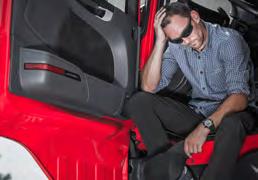






CARS • TRUCKS • JOBBERS C-STORES • INSTALLERS • RECYCLERS CARWASHES • SERVICE STATIONS DEALERS • GARAGES • BODY SHOPS & trucking auto WINTER PIECE OF MIND ON THE ROADS (STORY ON PAGE 24) NEWS OF THE WEIRD! (SEE PAGE 14) EVS IN WINTER WEATHER (PAGE 16) WINTER 2024 FREE REALITIES OF BURNOUT! (PAGE 10) GIVERS AND TAKERS (PAGE 22) SOFT SKILLS, HARD CHOICES (PAGE 18) .com CANADIAN AUTOMOTIVE TRENDS IN 2024!

Call us:
1-902-452-0345
E-mail us: rob@autoatlantic.com
Mail us:
608 - 56 Jacob Lane Bedford, NS B3M 0H5 Canada
PUBLISHER
Robert Alfers rob@autoatlantic.com
EDITOR
Carter Hammett carter@autoatlantic.com
EDITORIAL INTERN
Kirk Mathieson
REGIONAL SALES
Angela Jorgensen angela@autoatlantic.com
IT MANAGER
Tyler Graves tyler@autoatlantic.com
Auto & Trucking Atlantic is published digitally by Robert Alfers. For advertising rates or information regarding Auto & Trucking Atlantic, please call or Email us at: info@autoatlantic.com.
Tel: 902.452.0345.

Page 4
Page 14
Page 16
Page 22
Page 28
Page 36
DEPARTMENTS
EDITOR’S LETTER – Still Standing in 2024. It’s a sad but sobering fact: one Canadian publication dies daily. But we’re still standing…sort of.
NEWS OF THE WEIRD – Toaster used to keep battery warm sets car ablaze in Europe. Plus more!
ELECTRIC AVENUE – If you’re a proud EV owner, here’s a primer on keeping things rolling along during Ol’ Man Winter.
WOMEN AND WHEELS – In which Ellen Voie muses on givers and takers in the trucking industry.
THE ATLANTIC ROAD REPORT – New Brunswick releases three-year Capital Investment Plan. Plus more!
TALK OF THE TOWN – Columnist Sean Maddox recalls halcyon days on his first e-scooter.
FEATURES:
Page 6
Page 10
Page 18
Page 32
Page 24
Page 26
Page 30
CANADIAN AUTOMOTIVE TRENDS IN 2024 – With incentives for EVs, increased vehicle connectivity and the impending reality of autonomous vehicles, contributor Sebastien Dorelas offers insight into what can be expected in the months to come.
THE REALITIES OF BURNOUT – With the lonely long days on the road and the lonely long nights away from loved ones, burnout becomes a very possible risk for truckers, writes Felicia Burchell.
SOFT SKILLS, HARD CHOICES – Carter Hammett offers his take on the skills employers will be looking for in the not-so-distant future. But just what the heck are soft skills anyway?
TRENDS IN TRUCKING 2024 – With driver and equipment shortages among the plethora of problems the trucking industry faced during a very tough year, our Mindful Trucker speculates on what’s coming down the pipeline later this year.
A WINTER PEACE OF MIND – Alexander Johnson offers his thoughts on outfitting your vehicle with the proper snow tires.
“ALL ABOUT QUALITY”- Craig’s Auto Clinic in Fredericton N.B., keeps tradition alive with one eye on the automotive future, writes Kristen Lipscombe.
FAMILY MATTERS – Traditional positive values the key to success a CSN Keizer’s Collision Centre in Halifax. Kristen Lipscombe profiles a business that’s been a big part of the community for over three decades.
VOLUME ONE • ISSUE 1 • WINTER • 2024
visit
scan &
our online hub!
atlantic.com
trucking
auto &
3 autoatlantic.com n winter 2024
STILL STANDING IN 2024 . . .
By Carter Hammett
DON’T YOU KNOW I’M STILL STANDIN’ BETTER THAN I EVER DID? LOOKIN’ LIKE A TRUE SURVIVOR, FEELIN’ LIKE A LITTLE KID, AND I’M STILL STANDIN’ AFTER ALL THIS TIME PICKIN’ UP THE PIECES OF MY LIFE WITHOUT YOU ON MY MIND I’M STILL STANDIN’ (YEAH, YEAH, YEAH) . . .
It’s hard to believe that song by Elton John is already 40 years old.
But it really resonates after a rough year. 2023 will be remembered as an “annus horribilis” for many of us here at Auto and Trucking Atlantic. Parents passed away. Relationships went south. Mental health suffered. A friend died of cancer.
But we’re still standing. A little battered perhaps, less than perfect for sure. A little thinner.
But we’re still here.
And that position has been assumed after a few tough choices. We’ve decided to cut back from bimonthly to quarterly. Our paper edition is now a thing of the past as we move completely online.
For us the move makes sense: It’s a survival tactic. And reflective of the way Canadian periodical publishing has been declining for over a decade now.
According to Statista.com, the number of Canadian magazine readers fell from 17.2 million in 2014 to 15.9 in 2016. During that same period, revenues from periodical sales fell by a whopping 79 million U.S. dollars.
Interesting to note that recent data shows that 44 percent of Canadians between 21-and-34 years old read magazines weekly while those of us in a higher age bracket clock in at 67 per cent.
It may surprise you to know that Canada’s best selling monthly publica-

tion is….drum roll…Reader’s Digest. In fact, Canada’s best-selling magazines like Chatelaine and MacLean’s are doing just fine, thank you very much. In Quebec, Ricardo keeps on keeping on. But the fact remains: one Canadian publication dies every single day.
So, we have to look at alternatives. For some, including us, e-publishing is the way to go. However, e-magazines still play second fiddle to e-books. In 2017, e-magazines generated a healthy-sounding $13 million. Compare this to e-books however which pulled in $359 million U.S. dollars in Canada. That same year, only six percent spent money on e-magazines, compared to 17percent of Canadians spending money on e-books.
There are a few bright spots however. Many magazines are going the niche route, and using their publications to promote a company’s products but only publishing once or twice a year. Advertising revenues, while down over $100 million in 2017, only drew 29 complaints in 2017, compared to over 700 ads shown on TV.

That really isn’t too bad. And while many have been sounding the death alarm of Canadian publishing for some time now, we can honestly say, we may be down, but we’re not out. It’s interesting to think about how vinyl records have made a surprising and successful comeback in recent years and we entertain hopeful thoughts for something similar in the publishing world. You never know. We remain hopeful. And we’re still standing!
Letter from the Editor
4 autoatlantic.com n winter 2024

CANADIAN AUTOMOTIVE

6 autoatlantic.com n winter 2024
AUTOMOTIVE TRENDS IN 2024!
 By Sebastien Dorelas
By Sebastien Dorelas

DESPITE THE PANDEMIC AND GAS PRICES GOING UP OVER THE LAST FEW YEARS, THE AUTOMOTIVE INDUSTRY HAS REMAINED FAIRLY STABLE. IN FACT, CANADA SAW ITS NUMBER OF SOLD VEHICLES INCREASE BY 5.2% FROM 2022-TO-2023.
Many consumers are still looking for affordable, reliable and quality vehicles. According to an Asking Canadians survey by KPMG, more than six-out-of 10 Canadians are considering purchasing new vehicles in the next five years.
As new technologies continue to evolve rapidly and environmental innovations are shifting this industry in new directions, consumers are looking for a new car that will lead them into the future. If this is your situation, you will need to do some research to establish what car will be the best option. Before you
finish up your search and zero in on your new wheels, here are three trends to look out in 2024:
TREND #1 – ELECTRIC VEHICLE ADOPTION
Opting for an electric vehicle (EV) is choosing to go places while investing in our planet’s future. EVs offer great value while being fuel-efficient. Besides, they are affordable and have one of the best resale values on the market. The federal government is providing up to $5,000 in incentives for Canadian consumers who buy or lease a fully electric or plug-in hybrid EV. This program should continue until March 31, 2025.
Contrary to popular belief, vehicle electrification doesn’t equate to completely ending gasoline usage. In fact, there are two types of vehicles available right now: the plug-in hybrid electric (PHEV) and the battery-electric (BEV). The PHEV offers two sources of power so drivers can drive further while reducing carbon emissions. A PHEV possesses both gas engine and electric motors. These vehicles provide the possibility of switching between gas-mode only to electric-mode only. Instead of the commonly used combustion engine, the BEV relies entirely on the power of electricity to function. You will need to charge your BEV. Drivers can install a charger at home, workplace or access the nearest charging station.
Both of these offer advantages. Consumers may consider a PHEV as they provide more flexibility with gasoline and electric-only
options. BEVs have larger and bigger batteries which can help reduce your carbon footprint. In both instances, charging may be an issue for people living in remote areas as infrastructures are still expanding. Eco-conscious drivers will want to explore the following vehicles: Nissan Leaf Plus, Hyundai Kona Electric and Tesla Model 3 Long Range. These three have been named amongst a list of best EVs for Canadian winters.
TREND #2 – CARS BECOME EVEN MORE CONNECTED!
Connectivity is another important factor for many Canadian drivers. Let’s face it: our roads are long and wide covering several provinces from coast-to-coast. In fact, the Trans-Canada Highway is the longest uninterrupted route in North America. According to StatsCan, 80% of Canadians commuted to a location outside their home for work in May 2023. This number reiterates the importance for Canadian drivers to be well connected whether they are driving for work or travelling for leisure from a city to another region. Connected cars receive software updates, communicate with emergency services and offer intuitive entertainment systems such as Apple CarPlay or Android Auto. Technology features and drivability are more than ever intertwined. More companies focus on improving the overall driver and passenger experience on the road. Here are two features to consider in the connectivity category:
7 autoatlantic.com n winter 2024
HEADS-UP DISPLAY (HUD)
Amongst the many features available, the heads-up display (HUD) seems to have become popular lately. Manufacturers like Toyota, Hyundai and Buick are offering this amazing feature in their new models.
This technology provides an image with key information in the driver’s field of vision, just beneath their line of sight. This tool is additionally a safety feature that doesn’t distract the driver. There are three types of displays: in-car, apps and third-party.
Each type has pros and cons. For example, the built-in system is made perfectly while being included in the financial bundle with one vehicle. That being said, it cannot be moved from one vehicle to another. The HUD apps are usually free and easy to install on your mobile. Keep in mind that you need to focus on the
road. Therefore, you need to anchor your phone to the dashboard without obstructing your view. Finally, if you want to choose very specific features, an aftermarket HUD might be something to consider. Keep in mind that they are expensive and may clutter your dashboard. Drivers should factor in pricing, display size, visibility and even ease of use to determine the one that fits their needs best.
SMART SENSORS
One of the most popular automotive safety features are smart sensors. If safety is a top priority, then rest assured the majority of 2024 models are focusing on providing you with peace of mind. Thanks to the smart sensors, Canadian drivers will feel more comfortable maneuvering their vehicles. Car sensors are electronic devices which are located everywhere in your vehicle. They observe and monitor the vehicle; they transmit information to the driver regarding different aspects of the vehicle such as temperature, engine and vehicle speed. In addition, they provide realtime information on the control system ensuring the safety of occupants once you start your engine.

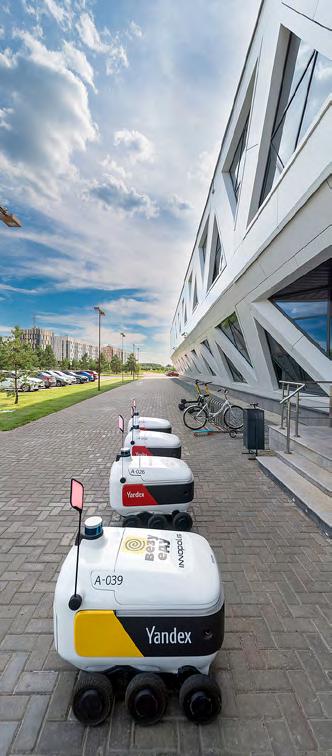
stacles in front or behind your vehicle as you are about to park. The fuel temperature measures fuel entering the engine.
Overall, a car can have up to 70 different sensors. Each one of them will record a different component of the vehicle. They all aim to provide safety for drivers and passengers.
TREND #3 – AUTONOMOUS DRIVING IS GETTING CLOSER!
Many 2024 models are equipped with a great many sensors. The parking sensor is a popular feature that can help detect ob-
The idea of self-driving vehicles always seemed to be only a fantasy in sci-fi movies. Some American cities however, like San Francisco are currently experimenting with brands like Robotaxis.
These are self-driving cars making driving decisions. As technology progresses, we are getting closer to seeing the first iteration of
8 autoatlantic.com n winter 2024
driverless cars on Canadian highways.
Autonomous vehicles rely heavily on sensors, cameras, radar and artificial intelligence to travel from point A to point B without a driver. They respond well to simple things like stopping at a red light or staying in-lane. However, things get more complicated in active environments such as a downtown core.
Several issues such as performance, traffic and weather conditions tend to disrupt these vehicles. Autonomous vehicles lack basic understanding of the complex nature of the dynamics with other motorists such as cyclists and pedestrians. Ontario is the only Canadian province allowing autonomous vehicles on the road for testing purposes.
While autonomous vehicles are currently being tested in California, semi-autonomous cars like the Tesla Model 3 offer this amazing feature.
Semi-autonomous cars are able to keep in-lane and can also park themselves. Drivers must keep their hands on the steering wheel at all times. While these vehicles are already on our roads, a study from the University of Windsor demonstrated that drivers getting behind the wheel of a semi-autonomous car don’t pay attention to the road.
A full transition to autonomous vehicles in Canada may not happen overnight as we have a lot of challenges to face and a lot of questions needing answers. The automotive industry and governments must look for new regulations around this new segment of vehicles.
The future for Canadian drivers looks bright and filled with promising technologies that will improve the experiences in 2024.
While semi-autonomous vehicles are perceived as luxurious for the average Canadian driver, auto -
motive experts predict that once these vehicles become authorized on our roads, safety will significantly increase.
Sebastien Dorelas is a communication and media specialist with over 12 years of experience creating, curating and managing digital content and stories to build relationships between organiza-
tions and individuals. Sebastien graduated from Communication Studies at Concordia University (BA 09) and has two graduate certificates from Humber College (2018). He wrote for several public publications in English and French.
He is passionate about current affairs, media and travel. You can follow his travel adventures via his social accounts.
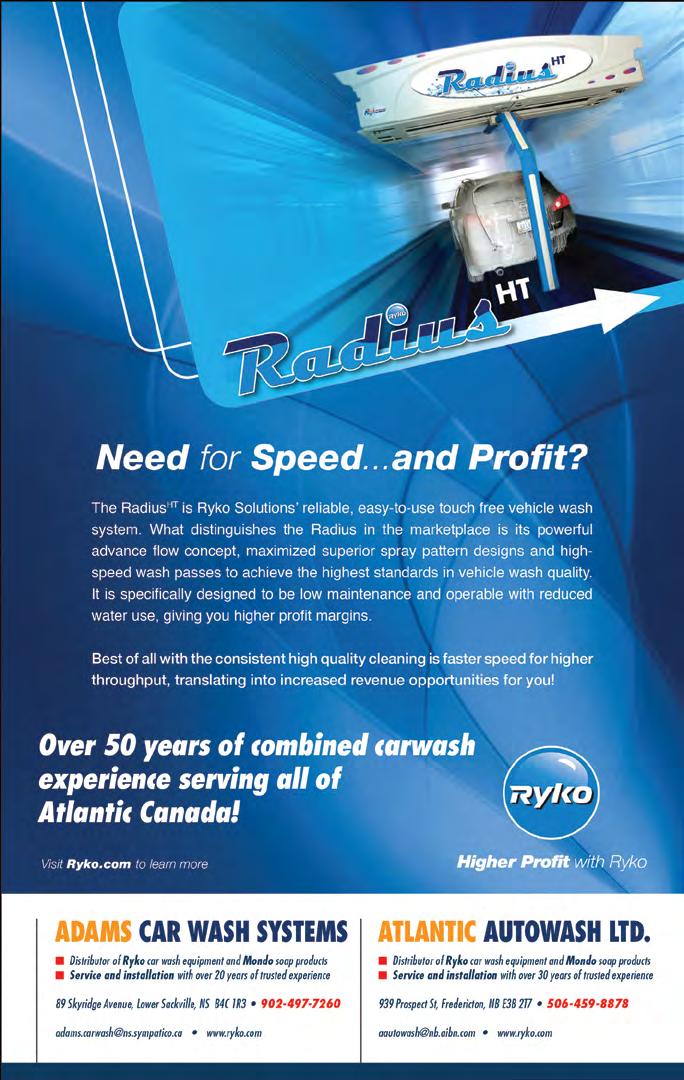
Truckers Corner
9 autoatlantic.com n winter 2024
THE REALITIES OF BURNOUT
WITH ISOLATION, LONG DAYS ON THE ROAD AND PROLONGED PERIODS AWAY FROM LOVED ONES, TRUCKERS ARE AT RISK OF MENTAL HEALTH CONCERNS LIKE BURNOUT.
By Felicia Burchell B.Sc.O.T. Reg (NS, NB, PE), RCT, CCC

HERE ARE SOME TIPS AND TRICKS TO HELP KEEP YOU AFLOAT.
Burnout. We have all heard the term but what exactly does it mean? From a physiological perspective, burnout is a dysregulation of the body’s nervous system and various hormones due to exposure to chronic stressors. Sustained release and overproduction of our stress
hormone cortisol, places our body in a state that can result in a host of symptoms including low-grade inflammation, impaired immunity, sleep disturbances and hormonal imbalances over time.
We need to examine the symptoms of burnout to identify it. People frequently talk about being worn out, overburdened, uninspired, and disengaged. Physical symptoms could include changes in eating and sleep patterns, fatigue, and an increased susceptibility to illness. Other symptoms can include headaches and stomach or intestinal problems.
Feelings of unhappiness, self-doubt, helplessness, or detachment are examples of emotional symptoms. You might also observe that you’re isolating yourself from those around you and experiencing emotions leading to outbursts. This can im-
pact those who spend long hours on the road, either for work or pleasure. Truckers are already at risk of isolation, and when burnout is added to the equation they may not have the support needed to help them identify it.
Performing daily tasks may be difficult for you and you may find yourself procrastinating. Burnout can be caused by a stressful working environment, having too many responsibilities or prolonged levels of chronic stress. Some jobs have higher requirements for mental attention and physical work, without an outlet to resolve the stress; there is an increased risk of burnout.
So what causes burnout? High-pressure work environments, lack of recognition or overwhelming responsibility can be factors. A lack of work-life balance

Self Care
10 autoatlantic.com n winter 2024
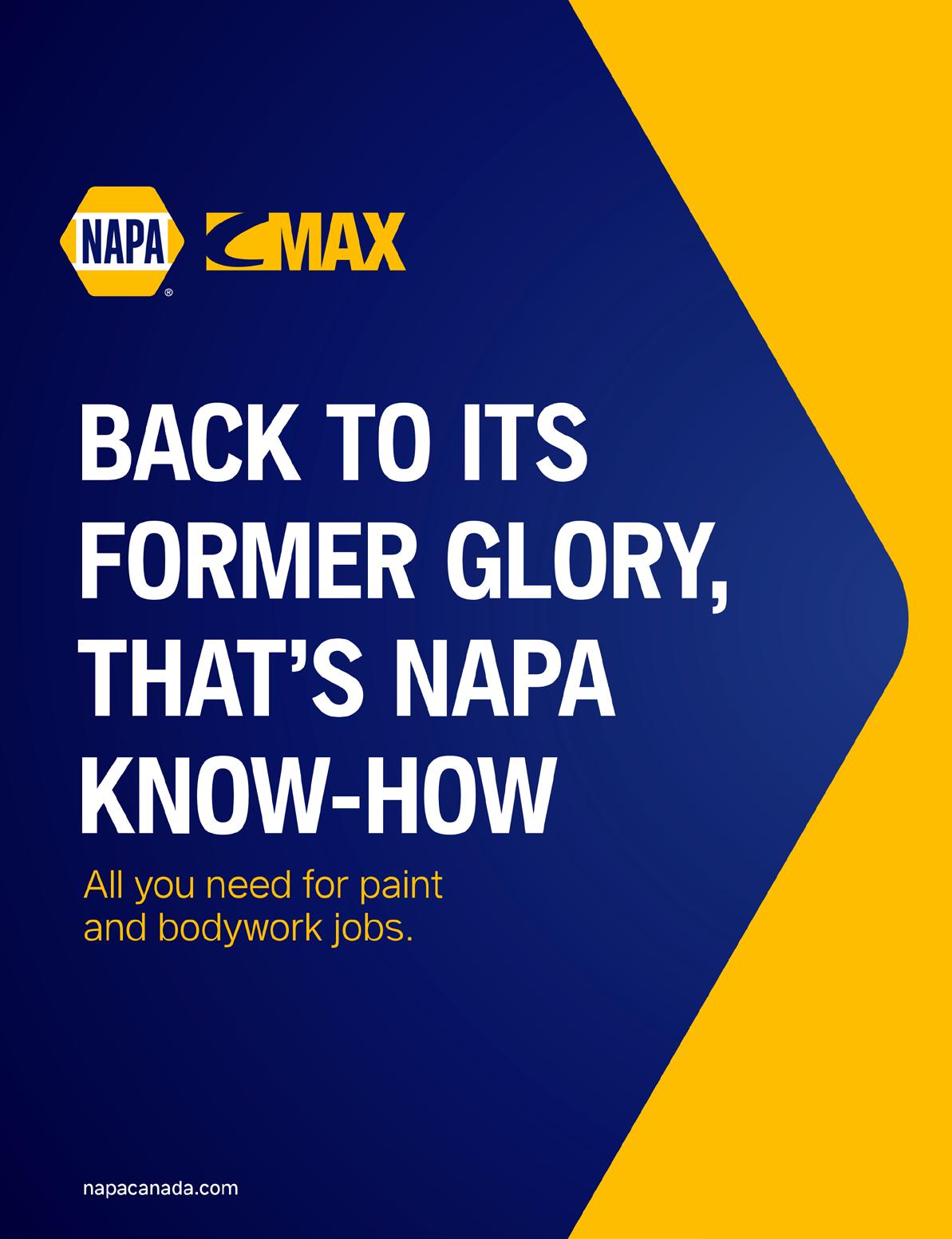

and unsupportive relationships as well as poor sleep further add to a sense of overwhelm. Other factors can include perfectionistic tendencies, a pessimistic view of the world as well and a need for control.
There is hope! Regaining balance in your life is a crucial part of healing from burnout. So what does healing from burnout look like? There is no one-sizefits all solution but there are strategies that can be helpful. The first thing in the healing process is finding somebody you trust to talk to. By seeking emotional support you can share what you’re experiencing.
Moving your body is an important aspect of general health and well-being and healing from burnout. It could be going to the gym and doing a workout or doing yoga, stretching or simply going for a walk in the fresh air. It’s all helpful and it all helps to moderate stress hormone levels, improve sleep, and overall reduce
inflammation. Building a bedtime routine to promote better sleep is important.
Long hours on the road can make it hard to maintain healthy eating habits, movement goals, and connection to those we love. However, there are still ways to engage in these recommended stress reduction activities that can be accommodated during long road trips. Video calls with loved ones or friends is a great way to connect to people you care about. Many hobbies can be taken on the road and don’t take up a great deal of space in the car. Even going for a walk or pulling over to sit and eat can be helpful!
Implementing boundaries as a way of prioritizing your time is key. Some have difficulties saying no which results in too much to do and not enough time to do it. Realistically looking at what we have time for and what we need and want to do can be the first step in making impor-
tant changes. Building a wellness routine is helpful in terms of having self-care activities that you practice on a day-to-day basis. These are activities that help to “fill your cup back up.”
This may include activities such as mindfulness, listening to music, reading a good book, spending time in nature or enjoying the company of friends. If you notice the feelings of burnout early on, it is much easier to implement changes. If you’ve been feeling this way for some time, it may be worth talking with a therapist. Therapy can provide a safe space to explore feelings, learn skills and strategies to help you with emotional regulation, managing stress, problem-solving and prioritizing yourself and your needs and wants. Many therapists even offer remote or virtual sessions to accommodate all walks of life. Please reach out. Talking and being heard is healing.
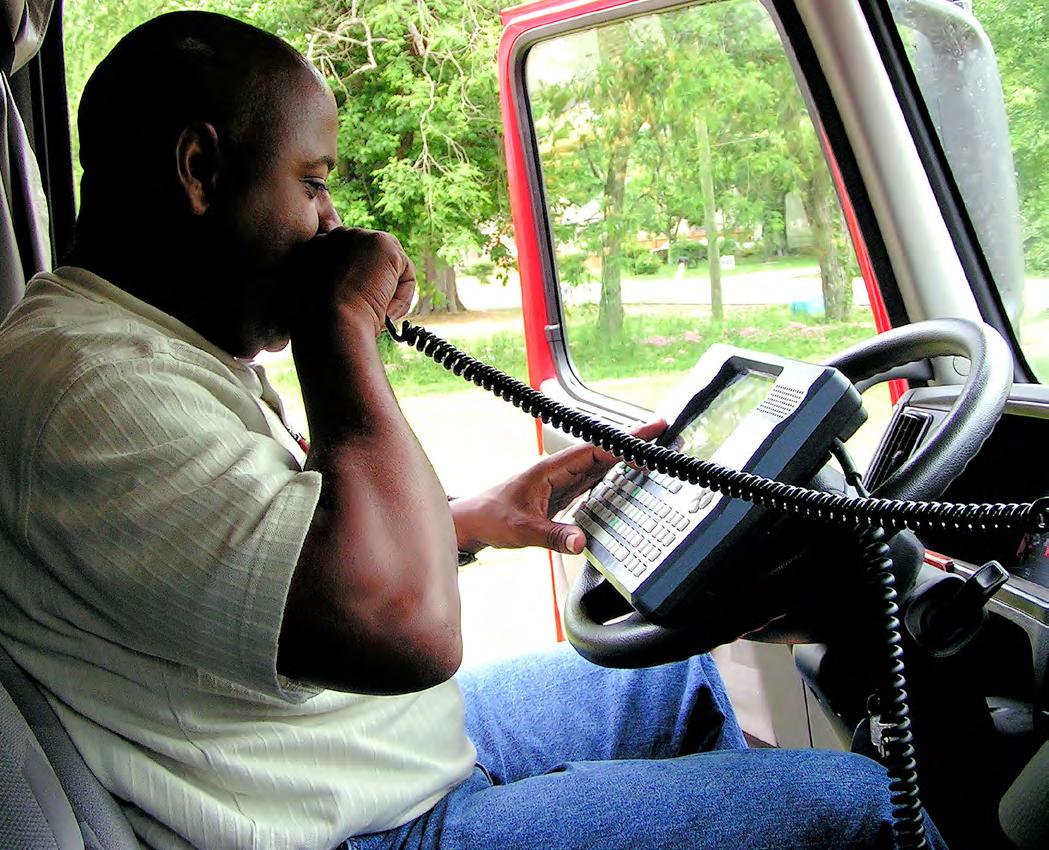
Self Care
13 autoatlantic.com n winter 2024
NEWS OF THE WEIRD
BITS AND PIECES OF THE BIZARRE, HORRIFIC AND THE DOWNRIGHT PUZZLING SCOOPED UP FROM VARIOUS PARTS OF THE WEB SO YOU DON’T HAVE TO! YER WELCOME!

EV FIRE IN CARPORT WAS LIKELY CAUSED BY THE TOASTER USED TO WARM THE BATTERY
A toaster placed under an electric vehicle by its owner to warm up its battery likely caused a fire that destroyed the car and damaged a nearby house in southern Denmark, police said Monday.
Police said that they “strongly discourage” people to use that method to heat power cells.
“The cause of the fire is most likely to be found in the toaster that the owner of the car had placed under the front of his car to keep the battery warm,” police said in a daily report.
The fire happened on a Saturday in Stenlille, about 60 kilometers southwest of Copenhagen. No one was injured.
The car was parked in a carport — a shelter for vehicles that is attached to a house and consists of a flat roof supported on pillars. The make of the car wasn’t known, and it also wasn’t immediately clear if it was the vehicle owner’s house that was damaged or a neighbour’s home. The car’s owner faces a fine.
https://www.autoblog. com/2023/12/04/ev-fire-in-carport-was-
likely-caused-by-the-toaster-used-towarm-the-battery/
SLEEP FOR AN OKLAHOMA CITY WOMAN RUDELY INTERRUPTED BY A FORD EXPLORER CAR CRASH
A bedroom is a peaceful sanctuary for many. It shields us from the troubles of the outside world. And we enjoy restful slumbers to recharge our batteries for the next day. Now, imagine as you’re sleeping, “catching some z’s,” and having pleasant dreams, suddenly, out of nowhere, a
big SUV comes crashing into your bed. That’s what happened to an Oklahoma City woman.
Late at night, a Ford Explorer drove through a residential neighborhood of Oklahoma City — near Northwest 64th Street and May. The driver lost control of the SUV, and it plowed through a fence. It then went through a second one on a wild journey through multiple yards of the neighbourhood.
After plowing through the two fences, the Explorer smashed through the brick wall of the woman’s house, creating a big hole. The SUV plunged right into the bedroom of the sleeping woman. The Explorer then slammed into the bed — and the force was so strong that it launched it four feet. After the Ford Explorer hit the bed, it knocked the woman off it. Miraculously, she only had minor injuries. An ambulance took her to a local Oklahoma City hospital, and she’s expected to make a full recovery.
https://www.motorbiscuit.com/ford-explorer-crashes-womans-bedroom-knocksher-bed/
“DUDE, SORRY I STOLE YOUR TRUCK”
Common courtesy and crime rarely go hand in hand, so a restaurant owner in Auckland, New Zealand, was understandably surprised when his stolen truck showed up largely undamaged outside of his business. The thief stayed anonymous but left a note and goodies in

News of the Weird 14 autoatlantic.com n winter 2024

the back. The pickup, a black first-generation Holden Colorado equipped with a roof rack-mounted tent, was stolen outside of an establishment called Kati Street on November 14, 2023, according to the restaurant›s Facebook page. It sounds like the owner, Varun Chada, started his truck that evening, left it running while he ran back into his building to grab something he forgot, and walked out to an empty parking spot.
Kati Street asked its social media followers to keep an eye out for the truck but no one managed to track it down. Four days later, the Holden re-appeared outside of the restaurant it was stolen from. The
keys were in it along with a hand-written note explaining what happened.
“Hey man, brought your truck back. Sorry, mate. Was drunk and needed a ride home,” the thief wrote on a page seemingly torn out of an agenda and dated April 17, 2014. He also went through the trouble of buying toys for the truck owner’s kid and leaving them in the truck.
Kati Street called the incident “totally unbelievable.” The restaurant explained that “[the thief] still mucked with [the truck] a little bit, but for the most part it’s all there and nothing was taken.” Let this happy ending serve as a reminder not to leave your car idling while unattended. Car thefts are rising in the United States, they›ve tripled in some cities, and leaving the engine running makes your vehicle an easy target.
https://www.autoblog.com/2023/11/30/ thief-returns-stolen-car-gifts-apologynote/
THE BIG LUBOWSKI?
On Nov. 4, 2023, Christopher John Lubowski led Houston police on a highspeed chase. The 51-year-old crossed four counties before law enforcement finally stopped his vehicle. That vehicle was a full-sized 18-wheeler. Surprising to no one, Lubowski hails from Florida. Consider that a warning: The Florida Man phenomenon has penetrated the greater Houston metroplex.
Lubowski has since been charged with possession of a controlled substance
and evading arrest. One question remains, however. This man drove a semi — one of those cargo-laden 18-wheelers that lumber on highways all over the USA — for 2.5 hours before the cops caught him.
So, just how fast can a big rig go?
Semis come with spectacular stats. Legally, an 18-wheeler must weigh between 30,000 pounds unloaded and 80,000 pounds loaded. The cargo compartment alone, unloaded, weighs around 10,000 pounds. Moving that heft takes power: A 15-liter diesel powerplant typically harnesses 400 to 600 hp and a fearsome 1,000 to 2,000 lb-ft of torque. The engine itself weighs as much as a Toyota Corolla.
Given those numbers, it’s hardly a surprise that a sufficiently motivated big rig might have a fair turn of speed. Per Freight Viking, a semi-truck without a trailer can do 0 to 60 mph in 15 seconds and reach a top speed of 125 mph. However, it’s unlikely that Lubowski’s tractortrailer traveled at that high rate.
Aside from the sheer engine power, three main factors make those numbers possible. First, Freight Viking’s figures are for trucks without trailers. Hooking on the five-ton box where 18-wheelers carry their cargo drags down their performance. Second, trucks need room to move, requiring a long, straight stretch of road to hit triple-digit speeds.
https://www.motorbiscuit.com/howfast-can-a-big-rig-go-truck-driver-testslimit-high-speed-police-chase
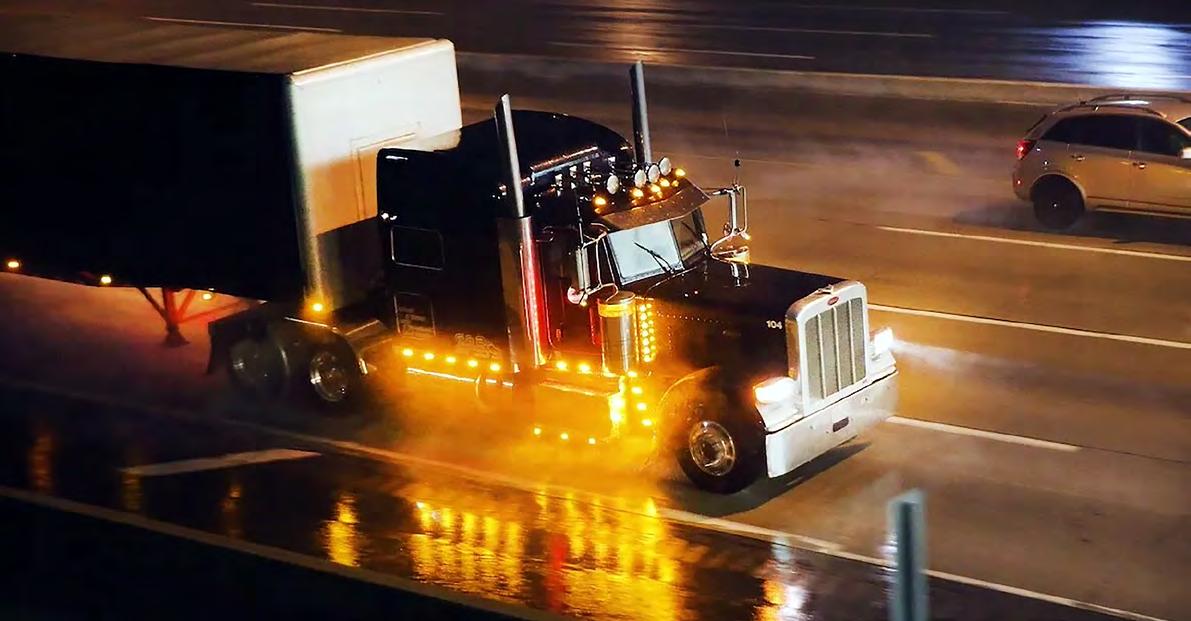
15 autoatlantic.com n winter 2024
DRIVING AN EV IN COLD WEATHER: A HOW-TO GUIDE
WINTER IS HERE AND POLESTAR PRESENTS SOME TIPS THAT WILL MAXIMIZE YOUR RANGE, OPTIMISE YOUR PERFORMANCE, AND KEEP YOU SAFE WHEN THE TEMPERATURE DROPS AND THE SNOW STARTS FALLING.
As more and more EVs are showing up on Canadian roads, people wonder how driving an electric vehicle differs from driving a gas-powered car.
The main reason EVs are affected by the cold is due to the temperature of the battery. If the temperature is too low, the electrochemical processes in the battery will slow down, which will affect both charging speed and range. In addition, heating the car’s cabin to a comfortable temperature requires more energy than it would in the summer.
Therefore, your guiding mantra through the winter months should be to keep you and your battery warm. And this is how it’s done.
PREHEAT YOUR CAR
Polestar, and most other EVs, have a preconditioning function. Other than providing you with a warm car, this saves you range as you won’t have to do it while you are driving.
If you schedule the preconditioning, your battery will also have time to warm up and be at a more optimal temperature when you set off.
The Polestar Plus pack is equipped with a special heat pump This equipment is a more effective heating system that controls your cabin temperature and uses less energy. This is not to say that the standard-equipped Polestar does not have heating. It›s simply a more premium piece of technology in the Performance pack that will extend your range during colder months.
DRIVE EFFICIENTLY
Range aside, when the roads get icy and the snow starts falling, safety is your first priority. The good news is that the safest way to drive during the winter is also the one that helps maximize your range. Remember to avoid accelerating
and braking quickly. Your wheels have less traction on snow and ice, meaning that quick acceleration and braking could result in the car skidding At the same time, by braking gently and maintaining a steady speed, you use less of your battery charge. But if you are just going out for a joy ride and not worried about maximizing your range, your Polestar is fully capable of taking on the snow with speed.
KEEP YOUR BATTERY CHARGED
If you are on a longer drive where you need to stop and charge, make sure to add a fast charger as a waypoint in your navigation system. Your Polestar will then make sure to heat the battery to the optimal level for charging by the time you arrive. This allows for quicker and more efficient charging.
You should also avoid completely running the battery down by keeping it at least above 20 percent. If you must leave your car in the cold, make sure it is sufficiently charged before.
This ensures that you have enough charge to heat the vehicle again and gives you the needed range.

Electric Avenue
16 autoatlantic.com n winter 2024

SOFT SKILLS, HARD CHOICES
WHAT WILL THE FUTURE OF WORK LOOK LIKE, WHAT SKILLS WILL BE NEEDED AND JUST WHAT THE HECK ARE SOFT SKILLS ANYWAY?
By Carter Hammett

IN A WORLD DRIVEN BY STEM AND OUTCOME MEASUREMENTS, IT BECOMES EASY TO SOMETIMES NEGLECT THE QUIET MURMURS OF SOFTER SKILLS.
Whether you’re a mechanic, a sales person, an apprentice or a parts guy, soft skills are in high demand—and will be in even higher future demand--by employers.
Let’s clear up a couple of things first. Just what exactly are soft skills? For the uninitiated, soft skills are qualities that
are an inherent part of you, that you’ll take with you from job to job, no matter what your profession. This can include things like good communication skills, being a team player, being a catalyst, being a critical thinker or a problem solver.
Hard skills, on the other hand are always learned, measurable and demonstrated. So, if you drive, speak another language,


Human Resources 18 autoatlantic.com n winter 2024
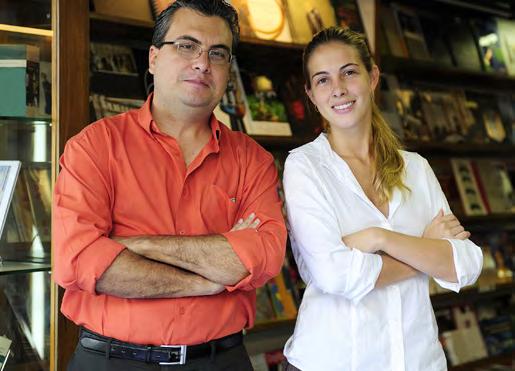
know first aid or drive a car, you have hard skills.
Unfortunately these tend to be the skills employers tend to value the most and use to measure success. But employers are waking up to the fact that it’s important to have skill sets that emphasize collaboration and problem solving. These become the foundation for organizational impact. Soft skills will vary according to industry, jobs, labour market information and changing trends. According to Careers in Automotive and Transportation Industries (cati.ca) four of the most important soft skills for auto mechanics, include customer service, organization, problem solving and team work.
Mechanics need to be able to interact with a wide diversity of customers, understand the problem that’s being identified and relay potential solutions in a manner that’s both timely and professional. Organization becomes important as a framework for health and safety. This skill set also helps mechanics prioritize and manage competing priorities. Problem solving abilities meanwhile enable mechanics to identify issues and solutions, understand your client’s emotional investment in the problem and work with efficiency. Finally, teamwork is critical for success in the mechanical field as it permits collaboration with others to reach a desired end.
Oddly enough the soft skill absent from this list and valued most by employers is communication. According to Forbes Magazine, communication is valued for a number of reasons. It’s essential for creating strong relationships with customers but also enables stakeholders to understand the needs of others while providing meaningful feedback. Communication skills take many different forms, including: active listening, cross-cultural communication, nonverbal communication, public speaking and presentation skills. This is perhaps the one skill most frequently sited by employers in performance reviews.
If someone were to tell you that soft skills are all in your head, they’d be right.
Another name for soft skills are executive functions and these skills sets reside in the prefrontal cortex of the human brain. They house, among other things stress and time management, working memory, decision making, planning, organization, priority setting, multitasking and logic among many others.
Executive functions got their name their name because many of these skills were deemed necessary for success in the workplace.
SKILLS FOR SUCCESS
Perhaps recognizing this the federal government recently introduced an updated version of their Skills for Success model.
Designed by Employment and Social Development Canada, the model identifies nine skills considered essential for success in today’s labour market. It’s interesting to note that of the skills identified,
four of these—continuous learning, working with others, oral communication and thinking—are considered “soft.” Three (reading, writing and numeracy) have never changed, while document use and digital skills are fairly recent additions.
Under the new model, communication includes non verbal communication and tonal, whereas “creativity and innovation” and adaptability are new additions, emphasizing the growing recognition of soft skills. Collaboration includes diversity in all its forms while Thinking skills includes critical thinking and problem solving.
FUTURE SKILLS
That model will change again, because it must. As futurists gaze into their crystal balls and try to look at societal and market changes, different skills will be needed to adapt and grow in response to market demand but also for self preservation. While it’s difficult to predict exactly which skills will come to the forefront, it’s interesting to see the ones identified by Indeed.com
The authors imply that along with helping you in career development the skills identified by Indeed can help you

19 autoatlantic.com n winter 2024
improve team work, adaptability, and bring additional value to companies that hire you among other benefits.
The skills they identify are: active learning, analytical thinking, complex problem solving, communication, cognitive flexibility, digital liter-
acy, emotional intelligence, leadership, interpersonal skills, initiative, creativity, technical design and self-management.
Quite different from the Skills for Success model isn’t it?
What’s notable as well, is that, with the exception of technical design aptitude and digital literacy, virtually every skill on the list can be considered “soft.” That’s a pretty big deal and something to think about as you consider future careers or lateral transfers for yourself. The other notable theme on this list is that virtually all of these skills transcend industry. In other
words they will be in demand to varying degrees across the board.
Cognitive flexibility allows you to multitask and adapt to different environments. People with these skills have
strong observation and comprehension competencies and jump into new situations in order to achieve company goals.
Something specific to the automotive industry could be, for example, complex problem solving. People who excel in this area will be able to quickly gather and analyse data and identify a solution. Given that most cars are essentially smart phones on wheels, this could be extremely important in the future. You can see that the onus will be on workers to commit to ongoing learning and continuous improvement.

That can put a lot of pressure on someone who’s not even sure what career they want to consider. But breaking things down and seeing - and owningwhat skills you have to offer and recognizing that they have value, can help you in the long run.
Human Resources
20 autoatlantic.com n winter 2024
THE GIFT THAT KEEPS ON GIVING
ADOPT A “TEACHING” MENTALITY IN ALL THINGS
By Paul D’Adamo

ARE YOU A HOARDER OR TEACHER? A TRUE “TEACHER” WANTS TO SHARE AND GIVE ALL THEIR LIFE EXPERIENCES AND KNOWLEDGE AWAY.
I started my tech career as a trainer for Wang Laboratories in Lowell, Massachusetts. I truly found my niche as I loved public speaking and as it turns out, training/teaching became a lifelong passion. It didn’t matter if it was colleagues, co-workers, children, students, or friends, I always wanted to share my knowledge and experiences to hopefully help the other person grow. It’s like the golden rule: treat others the same way as you wish to be treated. The only difference is to transfer handson, real-life knowledge to make things better.
TEACHING IMPACTS BOTTOM LINE
Please note that when I came into the auto recycling industry to help my fatherin-law turn around an old school junk-

yard, I quickly observed those that would share information and those that had a hoarder mentality.
For many folks, they have accumu-
lated a wealth of knowledge, and they fear that if they share it, they might lose their position, or more importantly, their position of power based on that accumu-

21 autoatlantic.com n winter 2024
lated knowledge and experience. Hmmm. Does that hit home for any of you? I took the exact opposite tack.
Job descriptions were written, explained, and updated accordingly. Interviews and on-boarding took on new meaning and we built a culture of change which meant a constant flow of information and teaching.
As it turns out, everyone’s time is extremely valuable. You can only delegate work to someone if they are fully trained in their specific role. Otherwise, you have built a system where everyone has to come to you to make decisions. You might like the role of decision maker but what happens when you want to take time off or make critical business decisions? You have deceived yourself by thinking you are the smartest person in the room, and nothing can happen without you. Ouch! The truth can really hurt. Hence the phrase “running around like a chicken with its head cut off”. You might be surprised by how liberating it is to have people make decisions on your behalf and allow you to do your job!
IS IT TIME TO BREAK THE CYCLE?
It is my firm belief that we have things backwards. We are so engaged to make sure our employees are productive, that we don’t take the time to assess our own productivity: not how busy you are, but how productive are you. You might have to sit down for a minute for this one. Do not confuse “busy” with “productive.” If you are always running around like a chicken with its head cut off . . . you are not operating at peak efficiency. And you are not dedicating enough time and energy to teaching, and ultimately delegating responsibilities and tasks. It is time to break the cycle.
A NOTE OF THANKS
I want to call out Greg DeBacco of Bill’s Auto Parts in Tolland, CT, Patty at Parts Unlimited in Texas, and Michael Tate at Mississippi Truck Dismantlers for reaching out to tell me they enjoyed reading my articles. It is a pleasure to express my thoughts and experiences through writing, and I appreciate positive feedback. The auto recycling industry is like no other and I feel blessed to be a part of it. I also appreciate that RAS has given me a platform to continue my passion for teaching through articles, public speaking, and working with customers one-on-one.
Need some tips on prioritizing your core program? Call or email me at Paul D’Adamo 401-458-9080 or pdadamo@ coresupply.com.
GIVERS AND TAKERS . . .
By Ellen Voie

WE ARE ALL FAMILIAR WITH THE FRIEND WHO FORGETS HIS WALLET WHEN IT’S TIME TO PAY FOR THE MEAL, OR THE ONE WHO ORDERS THREE COCKTAILS AND WANTS TO SPLIT THE CHECK DOWN THE MIDDLE (AND YOU DRANK WATER!) .
Maybe your neighbour borrows your leaf clippers each fall and then forgets to return them before spring.
Some people seem to take advantage of any opportunity to be on the receiving end or our generosity. They are the “takers,” described by Adam Grant in his book, “Give and Take.” A taker values material things, such as money, power, status and more.
Whenever I read any business books, I look for a connection to the trucking industry, and this book is no exception. For professional drivers, a taker is someone who parks at the fuel pump and then goes inside to use a rest room and eat, or worse, take time for a shower. They don’t care about your schedule or how long you’ll wait in line for diesel.
A taker only looks out for himself or herself. They don’t care if they leave trash in the parking lot or block another truck from that last spot. Having trouble backing into a dock? A taker will sit and watch you instead of offering to spot the trailer. Takers are easy to identify and someone to avoid. They feel the world is a competitive place and they must strive to overcome the competition.
According to Grant, a giver values social justice, compassion, helpfulness, and responsibility. A giver will offer you a shower voucher or offer to let you sit at his table to chat. Givers will help you clear your windshield after a snow-

Women and Wheels
22 autoatlantic.com n winter 2024
fall. Everyone likes to be around givers, as we appreciate their caring nature.
Some people view givers as weak, and easily manipulated. That may be the case for some people early in their careers who are less productive because they are helping others while still establishing themselves. Once the giver has influence, they are often the most successful.
A giver is also a networker. Consider someone looking for a job at a carrier and you know a driver or dispatcher there. Would you make introductions? Would you help a potential driver research truck driving schools in her area, so she makes an informed decision? Does it benefit you? If not, that’s okay with you because you want them to succeed.
There is a third category of individual called the “matcher.” The matcher keeps score and makes sure that she pays for lunch this time if you bought last time. He keeps track of how many times he’s helped you because he expects you to reciprocate in the future. A matcher gives to have a favour in his back pocket for next time. They value fairness.
If you think gender plays a role in whether we are a giver or taker, you’d be surprised to learn there isn’t a difference in the likelihood of being a giver or a taker. However, there is a difference in
how women approach giving compared to men. According to the author, women give to people they know, such as family members, friends, or colleagues. Women are more giving when the relationship is close to them.
Men are more giving when it comes to strangers. Men are more likely to help save someone’s life or help someone in need. For men, giving is more of an act related to ability than empathy and helping others shows a physical or mental proficiency.
There is an online test you can take to determine if you’re a giver, taker, or matcher. You may already have an idea based on your personality.
You can also be a giver in some situations, a taker in others and a matcher based on the interaction. The author shows how givers do achieve a higher level of success in life, so the next time you’re having lunch with a friend, offer to pick up the check, and then forget to keep score.
Women In Trucking Association’s mission is to encourage the employment of women in the trucking industry, promote their accomplishments, and minimize obstacles faced by women working in the trucking industry.


WINTER PEACE OF MIND
By Alexander Johnson

BACK IN 1985, THE DREAM ACADEMY CONTEMPLATED LIFE IN A NORTHERN TOWN, WHERE MORNING LASTED ALL DAY AND IT SEEMED LIKE THE WHOLE WORLD WOULD FREEZE.
But as the cold weather arrives and the chill of another Canadian winter season comes upon us, the challenges of navigating through snowy weather and icy road surfaces can leave even the most experienced drivers feeling more anxious than usual.
The fact is, winter is notorious for dangerous driving conditions. According to RCMP statistics, 30% of Canadian accidents occur on snow and ice - and this is with a much lower volume of cars on the road compared to the busy summer months.
The true key to keeping a car in control is tire grip; but when winter comes, many Canadians wonder whether winter tires are worth the cost and effort. The Tire and Rubber Association of Canada found that 70% of Canadians use winter tires in a given year. This number has doubled since 1998, when just 35% of Canadian vehicles wore winter tires.
Many provinces believe that is not enough, and they’ve created incentives for motorists in an effort to increase those numbers. Ontario and Newfoundland and Labrador’s legislation lowering insurance premiums for drivers using winter tires, British Columbia’s signage along select mountain routes, and Quebec’s 2008 statute mandating the use of winter tires from December 1st to March 15th are just a few examples.
Winter tires are built for a specific time of year. While all-season tires become rigid and lose traction at temperatures around 7°C and below, a winter tire is built with more flexible compounds and specially designed treads, allowing it to generate the heat and grip necessary for driving in difficult conditions. The deeper treads and additional siping ensure better traction on icy surfaces, while the tread pattern is specially designed to channel water and slush from
under the tire to prevent aquaplaning.
In terms of performance, winter tires have clear advantages in cold weather. According to the Traffic Injury Research Foundation (TIRF), winter tires have a better grip at -30°C than all-season tires have at 4°C. The TIRF’s recent study also found that vehicles equipped with winter tires require a braking distance of 6.4m on ice and snow, while all-season tires need 12.1m to stop in the same conditions. That six metre margin of safety can mean the difference between being in an accident and avoiding a collision altogether.
When buying tires, as with any consumer product, it pays to do research. There are hundreds of tire types and brands, with many designed for unique weather conditions or particularly demanding road surfaces. If you drive mainly on city streets, where slushy hills and hidden patches of ice can pose additional hazards, a tire that performs best on ice may be the one for you; on the other hand, if you live in a rural area, a tire designed for snow might be a better choice. Some winter tires are studded for extra traction in extreme conditions, but these tires are only permitted in certain areas for a specified length of time, so it’s best to check and see what’s legal in your area before buying.
The cost of winter tires can range from $120 -to- $200 per tire, and of course the regular season tires need to be stored for the winter. Look for the three peak mountain snowflake symbol, which appears on all tires that meet a higher- than- average standard for snow traction.
The best time to change over is earlyto- mid-October, when the weather in most parts of Canada starts to become unpredictable. It’s important to remember that when using winter tires, you must install four. Mixing tires can result in fishtailing and loss of control on both very slippery and high traction surfaces.
Are winter tires worth the investment? Manufacturers, experts and drivers have answered with a resounding ‘Yes.’ Accident reduction, lower insurance premiums and peace of mind are just some of the benefits of equipping a vehicle with the right tires for winter weather. As we head into another frigid season, being prepared can make all the difference. With the average vehicle owner in Canada driving just over 40km per day, the question to ask is, are we willing to put a price on winter safety?

Tires and Treads 24 autoatlantic.com n winter 2024
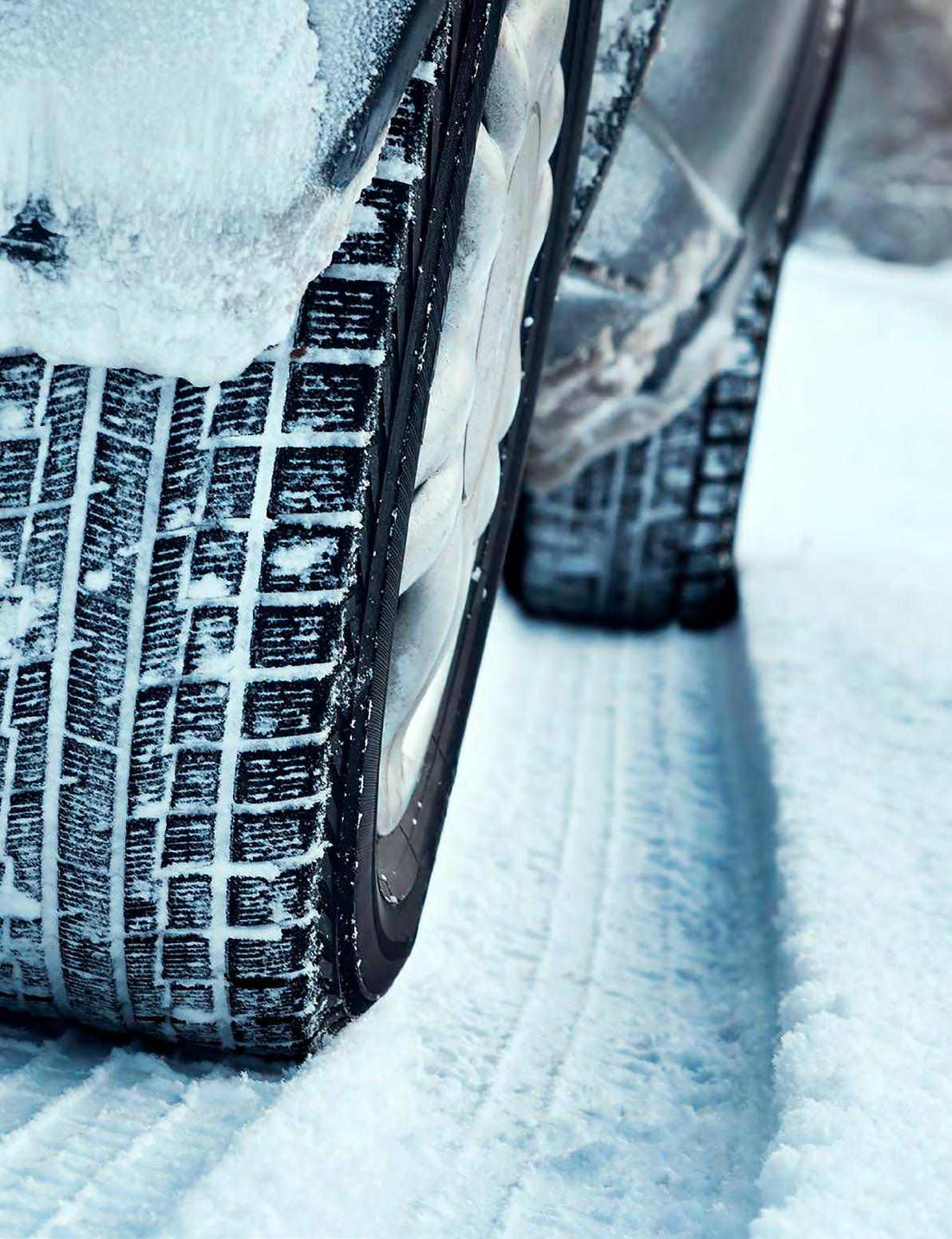
25 autoatlantic.com n winter 2024
“ALL ABOUT QUALITY”

NEW NAPA AUTOPRO FAMILY MEMBER CRAIG’S AUTO CLINIC KEEPS TRADITION ALIVE WHILE LOOKING TOWARD AUTOMOTIVE FUTURE
By Kristen Lipscombe

FOR CRAIG’S AUTO CLINIC IN FREDERICTON, ONE OF THE NEWEST MEMBERS OF THE NAPA AUTOPRO FAMILY, THE KEY TO RUNNING A SUCCESSFUL BUSINESS IS “QUALITY.”
“It’s all about quality repair, quality people and quality service,” Kyle Clark, who purchased the well-known NAPA AutoPro nestled at 120 Two Nations Crossing in the heart of the city about two and a half years ago, told Auto and Trucking Atlantic of what motivates him and his dedicated team members daily.
“The thing that really impressed me going into the business is the people that were there,” Clark said of his six current staff members, including four skilled technicians with a wide range of expertise and a couple of the friendliest front office employees in the industry.
“It was very easy for me to transition (into the NAPA family),” said 36-year-old Clark, who bought the established shop after leaving his sales position, one of many he held during his long automotive career at his family’s infamous Chevrolet dealership, which was sold off in mid-2019 after an incredible 105 years in business.
The Clark family brought the first and oldest Chevrolet dealership to Canada, a historical fact that is still proudly advertised on a display in the dealership featuring a series of photos of all the Clarks that have contributed to the business’s impressive ability to survive two world wars, the great depression and several recessions. None of these challenges over more than a century in business ever stopped the Clark family’s commitment to continuing its traditions of success through highquality customer service – and charitable service to community.

The family also runs the J.T. Clark Family Foundation, established in 1999 to help further its ongoing local philanthropy focused on charity causes that help “improve the quality of life for the people of New Brunswick and surrounding areas,” according to the foundation website.
Projects have ranged from healthcare and wellbeing, to buildings that support various community services, to initiatives focused on protecting the environment and encouraging sustainable projects.
NAPA AutoPro owner Kyle proudly serves on his family’s foundation board, and obviously comes by his commitment to quality naturally. In addition to
bringing his strong family traditions into his new business, however, Kyle is also fiercely focused on having his NAPA AutoPro location focused on preparing for the future of the automotive industry
When Kyle took on his new project, the shop had already previously joined the NAPA AutoCare Network, but after spending about a year getting to know his incredible employees, updating computer systems with more efficient technology, and had basically just setting up shop, he immediately knew what the next steps would be for continued success at Craig’s Auto Clinic.
“When they announced the NexDrive with NAPA and the EV (electric vehicle) support that they want to go after, well, you have to be an AutoPro to get that, and I want to be in on the first wave of those shops,” Kyle said of the importance of getting on board with the next generation of vehicles to hit the roads.
NexDrive powered by NAPA is the company’s newest vehicle training program geared toward creating “a service network of independent automotive repair shops that specialize in maintenance of electric and hybrid cars.
All technicians are NexDrive certified and carry out maintenance and repairs down to the last detail according to factory guidelines,” according to its website.
Kyle’s technicians were preparing to start NexDrive training in January, with one of his staff members – his 38 year old brother Jay Clark – already well-versed in

Around the Atlantic 26 autoatlantic.com n winter 2024
how to properly service eclectic vehicles.
“Our company’s legal name is actually Craig Electric Company – that’s what it used to be when it started almost 75 years ago,” Kyle said. “They were known for fixing starters and rebuilding things. So, I thought, well, Craig Electric Cars; when EVs become more popular, I want to be the first one in Fredericton.”
His business philosophy is simple. In order to maintain the historical reputation of providing high-quality customer service, you also have to be able to predict what’s coming next and prepare for providing that same high-quality care to customers in the future. “I’d rather be ready than trying to catch up.”
“I think there’s lots of talk out there, especially form automotive people in general, that it’s not coming, it’s slow, there’s no support; there are a lot of naysayers about it,” Kyle said, “but eventually in some iteration, there are going to be dif-
ferent cars, whether it’s different or current battery types, the current chargers we have, or not.
If we know anything about the technology industry, we know that it’s going to change.”
That’s why partnering with NAPA has become an important part of Kyle’s business plan. “With a group like NAPA, we’re going be ahead of what electric cars are going to look like.”
Electric vehicles aside, Craig’s Auto Clinic still offers all of the services and products you’d expect from any NAPA AutoPro location to “help keep your vehicle in excellent shape including preventative maintenance.
From oil changes and flushes to repairs and MVI, we can do it all,” the company’s website states.
That also includes a strong reputation for its diagnostic and electrical work, experienced brake work and knowledge,
top-notch steering and suspension repair, specialized air conditioning and exhaust expertise, all wheel and tire work, and everything in between.
“We’re all about effective diagnosis, effective repair and good communication,” Kyle said. “We also have really good people on the front counters to keep people informed, and good warranties to back it up with NAPA AutoPro.”
And with technicians on staff such as Richard Boutilier, who has worked at Craig’s Auto Clinic for 35 years, customers know they’re getting not just the newest automotive knowledge out there but also incredible experience that will ensure they get the best possible service available to them – no matter what they’re driving. “We like to make sure the repair is done right the first time, in a way that we would work on our own vehicles,” Kyle said. “What you get when you come to Craig’s is honest repair and quality repair.”
 (FROM LEFT TO RIGHT)
GINA PIETROGIACOMO (ADVISOR)
RICHARD BOUTILIER (TECHNICIAN) CODY CHAMBERS (TECHNICIAN)
KYLE CLARK (OWNER)
JOHN GOODINE (TECHNICIAN) CAMERON JOHNSTON (ADVISOR)
(FROM LEFT TO RIGHT)
GINA PIETROGIACOMO (ADVISOR)
RICHARD BOUTILIER (TECHNICIAN) CODY CHAMBERS (TECHNICIAN)
KYLE CLARK (OWNER)
JOHN GOODINE (TECHNICIAN) CAMERON JOHNSTON (ADVISOR)
27 autoatlantic.com n winter 2024
JAY CLARK (TECHNICIAN)
THE ATLANTIC ROAD REPORT
NEWS & VIEWS FROM AROUND THE ATLANTIC PROVINCES. YER WELCOME!
NEW BRUNSWICK
I am pleased to share the 2023 edition of the Department of Transportation and Infrastructure’s (DTI) 3-Year Capital Investment Plan for New Brunswick.
The updated version of the “The Road Ahead” maintains DTI’s goal to provide the best service possible while maintaining fiscal responsibility for our projects.
We have made significant progress on many new and ongoing Capital infrastructure projects since the release of our initial 3-Year Capital Investment Plan in 2022.
In St. Martins, the new Vaughan Creek Covered Bridge was completed in September, becoming the only two lane covered bridge in New Brunswick.
In October, Fredericton’s new Brookside Roundabout opened to traffic, a project made possible with the help of funding under our capital highway program.
While many communities celebrated the success of recently completed projects, “The Road Ahead - 2023” also details next steps for the renewal and replacement of many key assets, including some that are underway as part of multi-year construction plans.
This plan not only demonstrates how we manage our current transportation infrastructure, interact with communities, and collaborate with industry partners –it also shows how we will operate into the future with an active plan centered around DTI’s existing asset management principles.
We believe this rolling three-year plan will continue to demonstrate our commitment to transparency and accountability in communicating directly with New Brunswickers.
As the Minister responsible for DTI, this second edition of “The Road Ahead” provides the next step in our ongoing progress toward ensuring the travelling public has safe, reliable, and resilient infrastructure for years to come.
What is the Road Ahead Plan and why is it important?
In spring 2022, the Department of Transportation and Infrastructure (DTI) released its first 3-Year Capital Investment Plan, called The Road Ahead. This plan

outlined how DTI would build, repair and maintain the province’s transportation network. The 3-Year Capital Investment Plan details expected investments in our transportation assets, including highways, bridges, large culverts and ferries. The 2023 edition of The Road Ahead is the second release of a rolling 3-Year plan and identifies planned capital investments for the fiscal years 2023-2025. This edition of The Road Ahead includes an update on completed, new and ongoing projects and programs, including the status of the projects from 2022.
Developing and publishing a rolling 3-Year Capital Investment Plan demonstrates transparency and accountability regarding future projects and has several main benefits, including the following:
DTI has a defined plan for project implementation over the next three years.
The public is informed of when and where work is planned.
Industry has the opportunity to plan for upcoming work. Early identification of projects is a large step in efficiently delivering capital programs.
The public is informed on the status of ongoing projects and any changes to projects and/or programs.
Over the next three years, $1.3 billion is planned to be invested. The plan forms the basis for the multi-year budget submission and provides a level of detail that helps government understand the financial resources required to finance the
identified projects and programs.
This is a rolling 3-year plan, which provides projects for the fiscal years 2023 to 2025 and is updated annually to add future years’ projects. The plan forms the basis for the multi-year budget submission and provides a level of detail that helps government understand the financial resources required to finance the identified projects and programs.
Due to municipal reform, there is not currently a project list for The Provincial Municipal Highway Partnership (PMHP) program for 2025-26. The 2025-26 program is under development and will be published in the next edition of the Road Ahead.
NOVA SCOTIA
Province Reminds Drivers to Prepare for Winter Conditions
“Winter is coming, and it is important to prepare your vehicle to keep yourself

and everyone around you safe,” said Kim Masland, Minister of Public Works (photo above). “We are getting ready to do our part in keeping provincial roads safe. We ask all Nova Scotians to do theirs, too.”
To be ready for unpredictable winter weather, vehicles should have winter tires, cold temperature antifreeze and an emer-
East Coast Road Report
HONOURABLE JEFF CARR
28 autoatlantic.com n winter 2024
NB MINISTER OF TRANSPORTATION AND INFRASTRUCTURE
gency kit.
Other winter driving tips include: wearing seatbelts (seatbelts are required by law year-round)
slowing down and leaving additional space between vehicles; it takes more time and distance to brake in winter conditions maintaining a safe distance from snowplows to give operators room to do their job
keeping the gas tank at least half full planning ahead and allowing extra time for possible delays.
To help remind drivers to prepare for winter road conditions, the Province is also running its annual Be Winter Ready campaign. The campaign features television, radio and online ads that promote safe driving tips and share details about the tools and services that are available to make winter driving safer.
QUICK FACTS:
• the Department of Public Works is responsible for keeping provincial roads, highways and bridges safe and as clear as possible
• the Department operates more than 400 snowplows and other snow-clearing vehicles, and crews
are on the job day and night, 24/7
Additional Resources:
Department of Public Works Winter time web page: https://novascotia.ca/tran/ winter/
People with concerns about a provincial road can call the Department’s operations contact centre at 1-844-696-7737 or email dpw-occ@novascotia.ca
The online plow-tracker tool tracks snow removal on provincial roads: https:// novascotia.ca/tran/winter/plowtracker. asp
PRINCE EDWARD ISLAND
Get moving and apply for Active Transportation funds by December 1
The Active Transportation Fund is offering $5 million to grow PEI’s active transportation network. Indigenous and municipal governments and community groups are encouraged to apply to the Active Transportation Fund by December 1, 2023.
“The fund is making a positive difference in the lives of Islanders by creating more and improved options for travel and recreation. Getting people out of their
vehicles helps our environment and supports people of all ages and our communities.” - Transportation and Infrastructure Minister Ernie Hudson
Last year, 24 projects across the province received $5 million. Since 2020, government has invested in 106 active transportation projects including: 112 bike racks for schools and public buildings; 100 km of paved shoulders on roads and highways; 35 km of active transportation pathways.
“Funding has helped to build infrastructure so the community and visitors can safely access the Trail of Our Forefathers and it encourages people to be more physically active,” said Robin Enman, Sport for Social Development Coordinator, Lennox Island First Nation.
“We’ve put a lot of heart and effort into cleaning up the trail after Fiona to ensure people can enjoy it for recreation and educational purposes.”
The Active Transportation fund is a $25-million investment over five years that will support priority active transportation infrastructure throughout the province.
Active transportation is a self-propelled, human-powered form of transportation.

29 autoatlantic.com n winter 2024
FAMILY MATTERS:
TRADITIONAL POSITIVE VALUES DEFINE SUCCESS AT CSN KEIZER’S COLLISION CENTRE IN HALIFAX, N.S.
By Kristen Lipscombe

FOR JORDAN KEIZER, FAMILY IS THE DRIVING FORCE WITHIN BOTH HIS PROFESSIONAL AND PERSONAL LIVES.
In his work life, Jordan manages 16 employees at CSN Keizer’s Collision Centre on Hobsons Drive in Halifax, nestled in the always-busy Bayers Lake Industrial Park. He’s committed to treating all of his staff members with the same kindness and respect that he gives to his own relatives, which is no surprise, considering the impressive family history behind the well-respected Keizer’s brand, which spans more than four decades in the automotive industry across Halifax Regional Municipality (HRM).
“Everyone works really hard in our family,” Jordan said while taking a brief break from working right alongside his team members on car repairs in the large Bayers Lake back shop.
“I don’t know if it’s a trait or you’re brainwashed at a young age,” he said with a chuckle.
While Jordan, 29, runs the Keizer’s location in central Halifax, his older brother Justin, 33, runs OK Tire and his father Dale, 53, heads up CSN Keizer’s Collision, both located on Sackville Drive in Middle Sackville, which is the same area where patriarch grandfather John worked his way up from sweeping shop floors to owning his own body shop, kick-starting his family’s shared passion for everything automotive.
John, 74, is in fact still running Keizer’s Auto Sales, also in Middle Sackville, while grandmother Carol, 72, takes care of all the accounting for the various Keizer-run businesses. “She’s been saying she’s going to retire for the last six years,” Jordan said, “but she just keeps showing up to work.”
The family also owns Keizer’s Tire Auto Service on Cow Bay Road in Eastern Passage, a smaller shop that is wellrespected by the local community there.
“Everyone in the family is still very
involved,” Jordan said, adding he imagines that tradition will be passed down to his own three small children, and a fourth now on its way, with wife Morgan managing the home team while Jordan is busy at work from sunrise to sunset.
“I have a great wife,” Jordan happily admitted. “And that is a big part of it. By March, we’ll have four children under the age of four; I have two boys, a girl and another boy on the way.”

Brother Justin is also married, with two kids, so it looks like the Keizer commitment of strong family values and business ethics will continue to be passed down for many generations to come.
“You wear a lot of pride when you come to work every day and that’s your name on the building,” Jordan said of how the importance of family motivates him in every aspect of his life.
“I take full accountability for everything that goes on in the business,” he said of why he keeps himself not just aware of but involved in every aspect of CSN Keizer’s Collision Centre, from greeting customers with a warm smile and handshake at the front desk, to mentoring his apprentices and technicians in the garage, to ensuring everything is running smoothly operationally.
“I want to make sure that everything with our family’s company goes great,” Jordan said. “We’re very process driven, and to be honest, I’m probably harder on myself than I am on anybody else in our company, and I think it needs to be that way, especially from a manager’s point of view.”
It’s a positive business philosophy that has clearly been passed down through three generations – and more to come.
“So, I’ve got to to show up every day with the same mindset of… putting my best effort in and leading by example,” Jordan said. “I’m thankful for the team that I have here.”
Jordan’s enthusiastic attitude and dedi-
cation to hard work clearly does rub off on his employees, who are just as welcoming and friendly as their boss, a vibe that can be immediately felt by any customer who walks through the front doors of CSN Keizer’s Collision Centre, formerly known as The Coachworks Limited. The Keizer’s bought the business about ten years ago.
“It took a while to build the team,” Jordan said, explaining he kept some employees from Coachworks, moved some from other Keizer locations, and hired others along the way – with each and every staff member adding something special to his work family. “It’s created a great environment to work in.”
The passion that Jordan and his team have for their jobs at CSN Keizer’s Collision Centre have even recently resulted in national recognition. The shop falls under a network of companies called CSN Collision, which according to its website carefully selects automotive shops across the country “based on their business practices and high-quality repair standards.”
“It is the promise that you receive from your CSN Collision Centre that guarantees that your vehicle has been repaired to like-new condition so that you can get back on the road with confidence,” the website says.
In 2023, the Keizer location run by Jordan won both the Customer Experience Award, based on excellent reviews over the course of the year, and the award for Sales Growth of the Year across Atlantic
Around the Atlantic 30 autoatlantic.com n winter 2024
Canada, marking the second year in the row for that nomination.
“We’ve had awesome back-to-back years of very large sales growth in Halifax,” Jordan said, adding “there’s been a lot of work that has gone into that.”
Keizer’s Halifax was also nominated for Shop of the Year nationally and the Consumer Choice Award for Business Excellence in the Halifax region under the CSN Collision Centre umbrella, with an awards ceremony held in Muskoka, Ont., this past September.
Father Dale, of course, couldn’t be prouder of his son’s automotive accomplishments.
As a fairly new and young general manager, Jordan has faced and overcome industry learning curves in a short amount of time, coming out on top quickly, his father said. “He has been able to diversity his workload and organize floor production to increase sales and service values with staff.”
“We are extremely proud of his work ethics and continued growth in his leadership skills,” Dale told Auto and Trucking Atlantic. “He has accomplished an amazing amount of industry knowledge that is helping to keep all of our stores on the leading edge.” But Jordan in turns passes that credit back to his father, whose leadership and mentorship over the years has inspired him to be the very best professional and person he can be, from shop life to home life.
Much thanks to his father, collision repair became a natural career path for Jordan. Growing up in Middle Sackville, he would go to school during the day and then walk to the body shop down the road “to hang out with the guys.
“And when Dad was off work, I’d jump in the truck with him and we went home,” he said. “And that was pretty much my days. Jordan “didn’t even think twice” about what he was meant to do in life. “It was second nature.”
“I have a true passion for fixing vehicles,” Jordan said. “I took the trade out of high school, became an apprentice, worked on the floor and I’m red seal certified.”
“And I still work on them here and there where I can,” said Jordan, who was doing shop work the very day Auto and Trucking stopped by to chat with him about his business success.
Much like his grandfather and father, Jordan is always looking toward the future. He’s now hoping to connect with post-secondary institutions such as Nova Scotia Community College (NSCC) to encourage, mentor and teach young automotive professionals who may be interested in pursuing collision repair as a career path.
“We need to find fresh young people coming into the trade from school,” Jordan said. “It would be great to set something up with them, and have them in, and maybe show them through the shop,

and get to know the kids while they’re in school, and maybe set up an opportunity to have them work with us.”
Jordan’s advice to young people considering the automotive industry as a career?
“Just put your hands on cars,” he said. “As soon as you start taking something a part or figuring something out on your own, in your own way, it’s something you become proud of very quickly.”
Jordan said collision repair remains a growing trade “on the insurance side.”
“The work is there; it’s not going anywhere,” he said. “It’s quite busy with great opportunities for people to come in and make some good money within our companies.”
Beyond the Keizers and the work team he has built in his Bayers Lake collision shop, Jordan also looks at his customers as important members of his business family.
“At the end of the day, we’re here to serve a client,” Jordan said, “and give you the best experience possible.”

31 autoatlantic.com n winter 2024
TRENDS IN TRUCKING 2024
OUR PUNDIT TAKES TIME OUT TO REFLECT ON CHANGES COMING DOWN THE PIPELINE THIS YEAR FOR TRUCKERS AND THE TRUCKING INDUSTRY.
By Dana Smith

IT HAS BEEN QUITE A YEAR IN TRUCKING FOR 2023. A LOT HAS HAPPENED: FROM DRIVER AND EQUIPMENT SHORTAGES, TO HIGH FREIGHT DEMAND AND HEALTH & WELLNESS CHALLENGES.
All while trying to serve your customers with the best service you can give.
There will always be challenges to overcome in the transportation business. Some we can see coming, and others are unexpected. The ones we can see coming, we can prepare for, but what about the ones we can’t see coming?
The ones we can see coming are dictated by our data. Every company has it.
In order to understand your business and where it’s going, you need to track everything, so you have something to measure against, moving forward. This gives you a pretty good indication of what may be around the next corner.
#1: DRIVER RECRUITMENT
This one seems to be at the forefront for every trucking company moving into 2024.
Some say there is, or isn’t a shortage of drivers. It would depend on how you define shortage. If you have trucks sitting in your yard with no driver to move them, then you have a shortage, and that is costing you money.
Finding drivers isn’t the issue. Finding good qualified people that know and understand how to be a professional driver is the challenge. One that knows how to handle their truck in a professional, safe manner, day in- and-day out.
Most trucking companies are looking
for good qualified drivers. But they really are all picking from the same pool. As the older generation moves into retirement, there is an ever- growing need for younger drivers. There are now government programs that will help to alleviate that using immigration as a tool. Because of this, companies need to get creative when it comes to hiring. Many of them have a ton of new incentives.
#2: HEALTH AND WELLNESS CHALLENGES
Every company knows that good mental health practices and supporting your people when they need it, is good for business. During Covid-19 it was plain to see how that affected everyone’s mental health with all the lock downs. We need to have a proactive approach with mental health. It has a direct relation to absenteeism, and having productive people who will stay with your company for a long time.

The Mindful Trucker 32 autoatlantic.com n winter 2024
There are many ways to look at health and wellness strategies. Employee Assistance Programs (EAP), more home time, more corporate family activities, a more balanced work/life schedule. These are all things that can help your people excel at what they do.
#3: AUTOMATION / AI / SOFTWARE
Unfortunately trucks don’t drive themselves, or do they?. We have all heard about them, and they are a work in progress. Everyone is keeping an eye on these, as they could change the face of trucking altogether. Imagine being on the road with a transport truck with no driver in it. I can’t! If you have driven a truck lately, you will notice that trucks are very capable of doing a lot of the tasks you used to do, by themselves.
They are becoming more and more sophisticated.
The technology is moving at lightning speed these days, and more and more AI will be taking over the driving tasks for you. Who would have thought you would see driverless trucks on the road, never mind a computer that talks to you. This is what it is coming too. There are also
management software tools that integrate into the systems companies are already using. Examples of this include: a driver management system, maintenance software, truck/trailer relocation software and HR recruiting systems. All of these are brought together to make one seamless system that makes it easier to track everything your business does. These systems can reduce overall costs tremendously.
#4: LCV’S (LONG COMBINATION VEHICLES)
Very common out west, these are now in the east. These units can help alleviate some of the driver issues, as one truck can haul two trailers at the same time with one driver. However, these types of units are restricted to what they can do.
They are typically designed for highway use only, to move large amounts of freight quickly over long distances. Hauling double trailers can be a huge cost savings for small and larger companies alike.
#5: FREIGHT SHARING
What is freight sharing? This is where shippers and carriers are matched up based on a variety of factors, such as
weight, freight class, and distance travelled, and location to-and-from, to get the most optimal rates. Then both parties agree or decline the arrangement. It is a very efficient way to operate for all parties involved. Shippers get their products moved quickly, and the carriers get their trailers filled with freight. Empty miles cost everyone too much. Of course, using AI software to calculate all the factors, makes this a very quick operation that can be run from the palm of your handheld cell phone.
These are just some of many trends affecting the transportation industry over the next year or so. A couple of other things to mention are highway improvements and maintenance across the country, with a desperate need for improvements to rest areas along our nation’s highways. These should be a priority, as drivers are running on Elogs, and need a safe place to pull over at the end of their day. Happy trucking…
For more of Dana’s articles, be sure to check out his website at themindfultrucker. com

33 autoatlantic.com n winter 2024


35 autoatlantic.com n winter 2024
E
FOR FREEDOM
OUR COLUMNIST RECALLS HALCYON DAYS ON HIS FIRST VEHICLE.
By Sean Maddox

IN AUGUST 2018
I HEADED TO VAUGHAN AVENUE IN HALIFAX WITH THE SAME EXCITEMENT I HAD OVER 30 YEARS AGO WHEN I BOUGHT MY FIRST MOTORIZED SCOOTER.
I was filled with memories of cruising the city in high school and university on that gold Yamaha Elite. Whether it was to school, work, practice, or a night out, that first scooter proved to be more than a ride: it was freedom. The freedom felt being able to zip here and there in no time, on my own. The freedom to park in tiny spots or offer a close friend a safe ride.
Three decades have passed since that
first purchase. Over the years I owned a range of vehicles, learned to drive a standard in the mountains of Appalachia; through mud and stone in Africa; found what real off-roading means in Nunavut and navigated the transition from a navigator to a GPS. This time, the big difference was that the fuel source had changed. Now, instead of gasoline, the machine I purchased was powered by batteries, four lithium batteries to be exact. The batteries charged in no time, and a full charge was able to get me to Rainbow Haven beach and other hot spots around Halifax.
I had just moved back to Nova Scotia and needed to find a new home, vehicle, job, and such. The freedom offered by the scooter was just as I remembered and had hoped. Even better than I remembered because it was an E-Scooter: “E” for Electric, Environmental, and Efficient. My EScooter was built to go up to 50 km per hour, so it was treated as a bicycle under the legislation of the day making the third
E, efficiency, even more advantageous.
That scooter helped in so many ways. Even did its job in a snowstorm or two. It allowed me to travel when and where I needed with low costs (no insurance required), convenience, and the wonderful feelings on the ride. It allowed me to get around the city with ease and speed.
As life unfolded at home in Nova Scotia I found need for a larger vehicle for work, art and play. Constant clothing changes and helmet hair didn’t work well with consulting in Atlantic Canada, nor could I continue to carry excessive weights of art and supplies on these small machines. So off went another scooter to the growing market, and in came another four wheeled, petrol- powered car.
To this day all I can say from my experiences is you get what you pay for in the e-scooter market. Save yourself a headache or two, buy the best for your size you can afford, and keep your head up and eyes wide open.

Talk of the Town
36 autoatlantic.com n winter 2024
















 By Sebastien Dorelas
By Sebastien Dorelas



































 (FROM LEFT TO RIGHT)
GINA PIETROGIACOMO (ADVISOR)
RICHARD BOUTILIER (TECHNICIAN) CODY CHAMBERS (TECHNICIAN)
KYLE CLARK (OWNER)
JOHN GOODINE (TECHNICIAN) CAMERON JOHNSTON (ADVISOR)
(FROM LEFT TO RIGHT)
GINA PIETROGIACOMO (ADVISOR)
RICHARD BOUTILIER (TECHNICIAN) CODY CHAMBERS (TECHNICIAN)
KYLE CLARK (OWNER)
JOHN GOODINE (TECHNICIAN) CAMERON JOHNSTON (ADVISOR)














